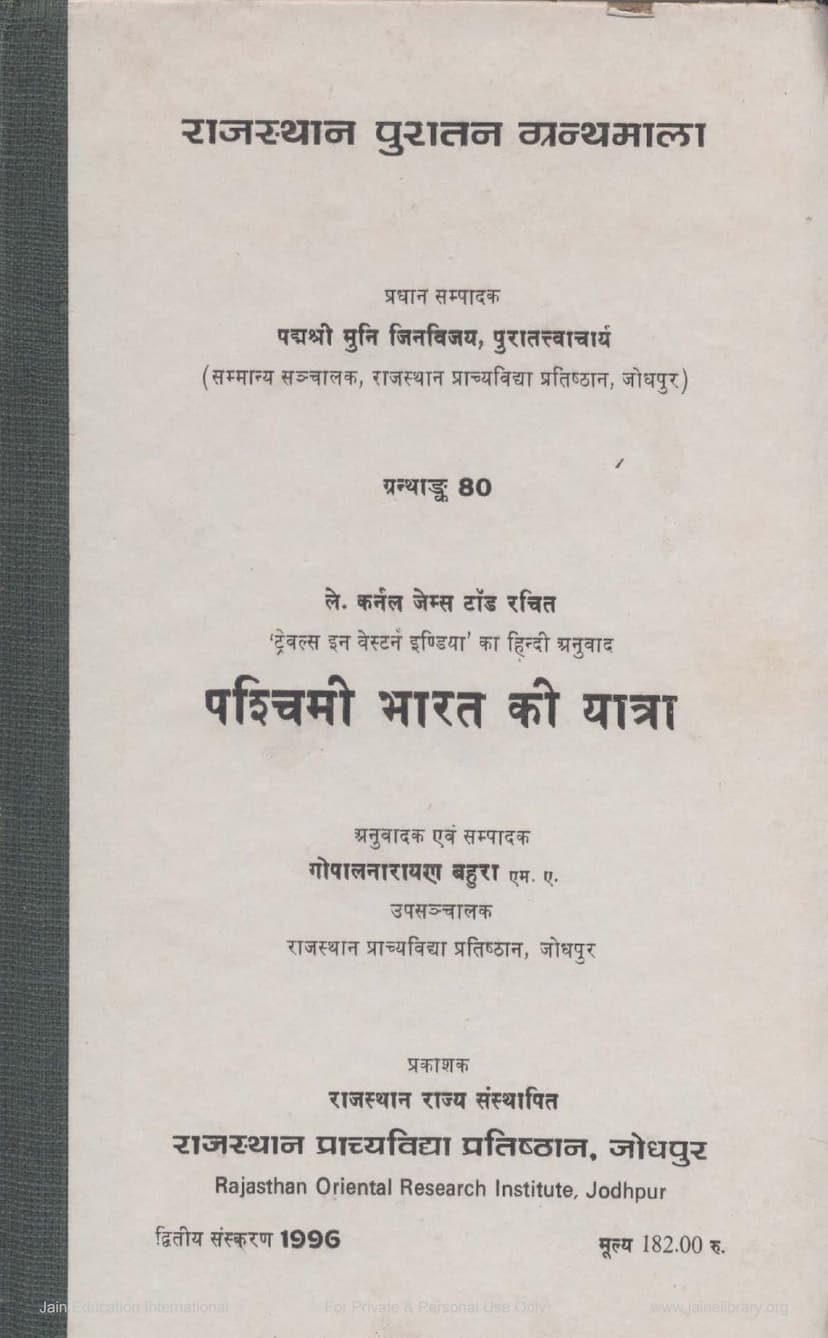Paschimi Bharat Ki Yatra
Added to library: September 2, 2025

Summary
Based on the provided text, here is a comprehensive summary of "Paschimi Bharat ki Yatra" (Travels in Western India) by Lt. Colonel James Tod, translated and edited by Gopal Narayan Bahura:
Overview of the Book:
"Paschimi Bharat ki Yatra" is the Hindi translation of Lt. Colonel James Tod's renowned work, "Travels in Western India." While Tod is widely celebrated for his "Annals and Antiquities of Rajasthan" (often referred to as "Annals and Antiquities of Rajasthan"), this book, "Travels in Western India," received less attention during his lifetime. Published posthumously in 1839, four years after Tod's death, it offers a detailed account of his journeys through various regions of Western India, including Gujarat, Rajasthan, and Saurashtra. The text focuses on the diverse sites he visited, detailing their temples, monasteries, stepwells, inscriptions, coins, and the rulers and events associated with them, providing valuable material for historical research.
Key Themes and Content:
-
Comprehensive Travelogue: The book serves as a detailed travelogue of Tod's extensive journeys. He meticulously describes the landscapes, climate, flora, and fauna of the regions he traversed. His observations are rich with historical context, drawing upon local legends, traditions, and his own interpretations.
-
Historical and Archaeological Observations: Tod was a keen observer of history and antiquities. He meticulously documented ancient sites, temples, stepwells, inscriptions, and coinage. His descriptions of the architectural styles and sculptural details of various religious and historical structures provide invaluable insights into the region's past.
-
Cultural and Social Commentary: Beyond mere historical accounts, Tod also provides commentary on the social customs, beliefs, superstitions, and daily life of the people he encountered. He offers insights into the character of various communities, including the Bhils, Meenas, Kolis, Kathis, and Rajputs, noting their traditions, attire, and way of life.
-
Focus on Jain and Hindu Sites: A significant portion of the book is dedicated to the sacred mountains and renowned shrines of the Jain and Hindu faiths. Tod's descriptions of places like Mount Abu (Arbudachal), Delwara temples, Shatrunjaya, Girnar, Dwarka, and Somnath are particularly detailed and evocative, reflecting his appreciation for their religious and architectural significance.
-
Historical Analysis and Interpretation: Tod often attempts to connect historical events and legends, providing his own interpretations. He delves into the history of various ruling dynasties, such as the Chauhans, Solankis, and the ruling families of Gujarat and Saurashtra, reconstructing their genealogies and significant events based on available inscriptions, local narratives, and his understanding of regional history.
-
Critical Engagement with Sources: The translation and editing by Gopal Narayan Bahura are notable for including critical notes and cross-references. Bahura's work highlights the historical context of Tod's writings, acknowledging the limitations of the sources available in Tod's time and pointing out where modern scholarship might offer different perspectives. The inclusion of original Sanskrit and Prakrit inscriptions (where translated by Tod) and the Hindi translation of their meanings enhances the scholarly value.
-
Tod's Personal Journey and Reflections: The book also offers glimpses into Tod's personal journey. He describes his failing health, his dedication to his work despite physical challenges, and his profound affection for the people, history, and culture of Rajasthan and Western India. His interactions with local rulers and his respect for their traditions are evident throughout the text.
-
The "Travels" in Context: The publication of "Travels in Western India" by the Rajasthan Oriental Research Institute signifies an effort to make Tod's less-known but equally valuable work accessible to Hindi readers. The introduction by Dr. Raghubir Singh and the directorial statement by Muni Jinavijayji emphasize Tod's contribution to understanding the cultural and historical landscape of Western India, particularly Rajasthan and Gujarat.
Specific Locations and Themes Mentioned:
- Rajasthan: Udaipur, Gogunda, Kotharia, Semur, Abu, Delwara, Achalgarh, Mount Abu.
- Gujarat: Ahmedabad, Patan (Anhilwara), Sidhpur, Khambhat (Cambay), Vallabhi, Palitana, Junagadh, Dwarka, Kutch, Mandvi, Bhuj.
- Themes: Jain pilgrimage sites, Hindu temples (especially Shiva and Vishnu), inscriptions, ancient cities, dynasties (Chauhans, Solankis, Bhaleras, Kathis, Gohils), local legends, social customs, influence of Islam, architectural styles, and the historical significance of ancient trade routes.
Significance of the Hindi Translation:
The Hindi translation by Gopal Narayan Bahura is a significant undertaking, making Lt. Colonel James Tod's scholarly work available to a wider audience, particularly those who may not have access to the original English or may prefer to read in Hindi. The critical annotations and the meticulous translation aim to provide a faithful and informative rendition of Tod's exploration of Western India.
In essence, "Paschimi Bharat ki Yatra" is more than just a travelogue; it is a rich tapestry of history, archaeology, culture, and personal reflection, offering a valuable window into Western India through the eyes of one of its most dedicated early European chroniclers.